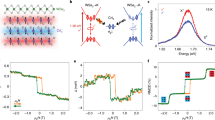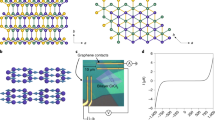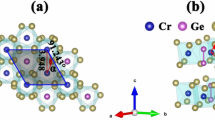Abstract
The atomic thickness of two-dimensional materials provides a unique opportunity to control their electrical1 and optical2 properties as well as to drive the electronic phase transitions3 by electrostatic doping. The discovery of two-dimensional magnetic materials4,5,6,7,8,9,10 has opened up the prospect of the electrical control of magnetism and the realization of new functional devices11. A recent experiment based on the linear magneto-electric effect has demonstrated control of the magnetic order in bilayer CrI3 by electric fields12. However, this approach is limited to non-centrosymmetric materials11,13,14,15,16 magnetically biased near the antiferromagnet–ferromagnet transition. Here, we demonstrate control of the magnetic properties of both monolayer and bilayer CrI3 by electrostatic doping using CrI3–graphene vertical heterostructures. In monolayer CrI3, doping significantly modifies the saturation magnetization, coercive force and Curie temperature, showing strengthened/weakened magnetic order with hole/electron doping. Remarkably, in bilayer CrI3, the electron doping above ~2.5 × 1013 cm−2 induces a transition from an antiferromagnetic to a ferromagnetic ground state in the absence of a magnetic field. The result reveals a strongly doping-dependent interlayer exchange coupling, which enables robust switching of magnetization in bilayer CrI3 by small gate voltages.
This is a preview of subscription content, access via your institution
Access options
Access Nature and 54 other Nature Portfolio journals
Get Nature+, our best-value online-access subscription
$29.99 / 30 days
cancel any time
Subscribe to this journal
Receive 12 print issues and online access
$259.00 per year
only $21.58 per issue
Buy this article
- Purchase on Springer Link
- Instant access to full article PDF
Prices may be subject to local taxes which are calculated during checkout




Similar content being viewed by others
References
Novoselov, K. S. Nobel lecture: Graphene: materials in the flatland. Rev. Mod. Phys. 83, 837–849 (2011).
Sun, Z., Martinez, A. & Wang, F. Optical modulators with 2D layered materials. Nat. Photon. 10, 227–238 (2016).
Saito, Y., Nojima, T. & Iwasa, Y. Highly crystalline 2D superconductors. Nat. Rev. Mater. 2, 16094 (2016).
Huang, B. et al. Layer-dependent ferromagnetism in a van der Waals crystal down to the monolayer limit. Nature 546, 270–273 (2017).
Gong, C. et al. Discovery of intrinsic ferromagnetism in two-dimensional van der Waals crystals. Nature 546, 265–269 (2017).
Yao, T., Mason, J. G., Huiwen, J., Cava, R. J. & Kenneth, S. B. Magneto-elastic coupling in a potential ferromagnetic 2D atomic crystal. 2D Mater. 3, 025035 (2016).
Du, K.-z et al. Weak Van der Waals stacking, wide-range band gap, and Raman study on ultrathin layers of metal phosphorus trichalcogenides. ACS Nano 10, 1738–1743 (2016).
Lee, J.-U. et al. Ising-type magnetic ordering in atomically thin FePS3. Nano Lett. 16, 7433–7438 (2016).
Zhou, B. et al. Possible structural transformation and enhanced magnetic fluctuations in exfoliated α-RuCl3. J. Phys. Chem. Solids (in the press).
Bonilla, M. et al. Strong room-temperature ferromagnetism in VSe2 monolayers on van der Waals substrates. Nat. Nanotech. http://doi.org/10.1038/s41565-018-0063-9 (2018).
Matsukura, F., Tokura, Y. & Ohno, H. Control of magnetism by electric fields. Nat. Nanotech. 10, 209–220 (2015).
Jiang, S., Shan, J. & Mak, K. F. Electric-field switching of two-dimensional van der Waals magnets. Nat. Mater. http://doi.org/10.1038/s41563-018-0040-6 (2018).
Chu, Y.-H. et al. Electric-field control of local ferromagnetism using a magnetoelectric multiferroic. Nat. Mater. 7, 478–482 (2008).
He, X. et al. Robust isothermal electric control of exchange bias at room temperature. Nat. Mater. 9, 579–585 (2010).
Heron, J. T. et al. Electric-field-Induced magnetization reversal in a ferromagnet-multiferroic heterostructure. Phys. Rev. Lett. 107, 217202 (2011).
Wu, S. M. et al. Reversible electric control of exchange bias in a multiferroic field-effect device. Nat. Mater. 9, 756–761 (2010).
Ohno, H. et al. Electric-field control of ferromagnetism. Nature 408, 944–946 (2000).
Chiba, D., Yamanouchi, M., Matsukura, F. & Ohno, H. Electrical manipulation of magnetization reversal in a ferromagnetic semiconductor. Science 301, 943–945 (2003).
Weisheit, M. et al. Electric field-induced modification of magnetism in thin-film ferromagnets. Science 315, 349–351 (2007).
Zhong, D. et al. Van der Waals engineering of ferromagnetic semiconductor heterostructures for spin and valleytronics. Sci. Adv. 3, e1603113 (2017).
Geim, A. K. & Grigorieva, I. V. Van der Waals heterostructures. Nature 499, 419–425 (2013).
McGuire, M. A., Dixit, H., Cooper, V. R. & Sales, B. C. Coupling of crystal structure and magnetism in the layered, ferromagnetic insulator CrI3. Chem. Mater. 27, 612–620 (2015).
Lado, J. L. & Fernández-Rossier, J. On the origin of magnetic anisotropy in two dimensional CrI3. 2D Mater. 4, 035002 (2017).
Song, T. et al. Giant tunneling magnetoresistance in spin-filter van der Waals heterostructures. Preprint at https://arxiv.org/abs/1801.08679 (2018).
Wang, Z. et al. Very large tunneling magnetoresistance in layered magnetic semiconductor CrI3. Preprint at https://arxiv.org/abs/1801.08188 (2018).
Stryjewski, E. & Giordano, N. Metamagnetism. Adv. Phys. 26, 487–650 (1977).
Wang, L. et al. One-dimensional electrical contact to a two-dimensional material. Science 342, 614–617 (2013).
Fallahazad, B. et al. Shubnikov-de Haas oscillations of high-mobility holes in monolayer and bilayer WSe2: Landau level degeneracy, effective mass, and negative compressibility. Phys. Rev. Lett. 116, 086601 (2016).
Wang, H., Eyert, V. & Schwingenschlögl, U. Electronic structure and magnetic ordering of the semiconducting chromium trihalides CrCl3, CrBr3, and CrI3. J. Phys. Condens. Matter 23, 116003 (2011).
Blundell, S. Magnetism in Condensed Matter (Oxford Univ. Press, Oxford, 2001).
Nogués, J. & Schuller, I. K. Exchange bias. J. Magn. Magn. Mater. 192, 203–232 (1999).
Arnold, C. S., Dunlavy, M. & Venus, D. Magnetic susceptibility measurements of ultrathin films using the surface magneto-optic Kerr effect: Optimization of the signal-to-noise ratio. Rev. Sci. Instrum. 68, 4212–4216 (1997).
Wang, Z., Chiu, Y.-H., Honz, K., Mak, K. F. & Shan, J. Electrical tuning of interlayer exciton gases in WSe2 bilayers. Nano Lett. 18, 137–143 (2018).
Acknowledgements
The research was supported by the ARO Award W911NF-17-1-0605 for sample and device fabrication and the Air Force Office of Scientific Research under grant FA9550-16-1-0249 for optical spectroscopy measurements. We also acknowledge support from the National Science Foundation under Award No. DMR-1420451 (L.L.) and DMR-1410407 (Z.W.), and a David and Lucille Packard Fellowship and a Sloan Fellowship (K.F.M.).
Author information
Authors and Affiliations
Contributions
S.J., K.F.M. and J.S. designed the study and co-wrote the manuscript. S.J. performed the bulk of the measurements and data analysis. L.L and Z.W. contributed to the sample and device fabrication. Z.W. and S.J. developed the experimental set-up. All authors discussed the results and commented on the manuscript.
Corresponding authors
Ethics declarations
Competing interests
The authors declare no competing interests.
Additional information
Publisher’s note: Springer Nature remains neutral with regard to jurisdictional claims in published maps and institutional affiliations.
Supplementary information
Supplementary Information
Supplementary Figures 1–6, Supplementary References
Rights and permissions
About this article
Cite this article
Jiang, S., Li, L., Wang, Z. et al. Controlling magnetism in 2D CrI3 by electrostatic doping. Nature Nanotech 13, 549–553 (2018). https://doi.org/10.1038/s41565-018-0135-x
Received:
Accepted:
Published:
Issue Date:
DOI: https://doi.org/10.1038/s41565-018-0135-x
This article is cited by
-
Tunable magnetic confinement effect in a magnetic superlattice of graphene
npj 2D Materials and Applications (2024)
-
Resonant Raman scattering of few layers CrBr3
Scientific Reports (2024)
-
Electric control of optically-induced magnetization dynamics in a van der Waals ferromagnetic semiconductor
Nature Communications (2024)
-
Two-dimensional magnetic materials for spintronic applications
Nano Research (2024)
-
Lead halide perovskite sensitized WSe2 photodiodes with ultrahigh open circuit voltages
eLight (2023)



